Envenomation
Author: Navdeep Sekhon, Assistant Professor, Baylor College of Medicine, Houston, TX
Editor: Lorraine Thibodeau MD, Associate Professor, Albany Medical Center
Last Updated: March 2019
Case Study
A 45-year-old male was working in his backyard in the United States when a snake began attacking his dog. As he went to the aid of his canine companion, the snake lunged at him and bit him on his hand.
He presents to your Emergency Department with a swollen hand with a blood pressure of 80/50 mmHg. When asked what kind of snake it was, he replies, “A scary one, Doc. How do we fix this?”
Objectives
By the end of this module, the student will be able to:
- Recognize the signs/symptoms of dangerous envenomations in the United States.
- Discuss the initial actions to help treat the patient with the common, acute envenomations in the United States.
- Discuss the appropriate management of common dangerous envenomations in the United States.
- Identify and avoid inappropriate actions previously recommended in treatment of certain envenomations.
- Contact the Poison Center (in the US: 800-222-1222) or medical toxicologist, especially when considering administration of antivenom.
Introduction
Few things scream Emergency Medicine as much as an individual running into the Emergency Department stating, “I got bit by a snake!” while carrying its headless corpse.
Thousands of patients every year in the United States present to the Emergency Departments with a suspected envenomation, and a successful clinician should know how to identify and manage each potential condition. Envenomation is defined as the act or an instance of poisoning by venom. In the United States, the most common dangerous envenomations are from snakes, spiders and scorpions, and they are relatively common. Between 2009 and 2013, over 35,000 snake envenomations were reported to the National Poison Data System in the United States.
This chapter will discuss the initial approach and management of envenomations, with particular regard to envenomations from snakes, spiders and scorpions that occur commonly in the United States.
Initial Actions and Primary Survey
Even though it may be tempting to focus on the envenomation site initially, the first priority is to assess and stabilize the ABCs. For envenomations, there are some special considerations to pay attention to when addressing the ABCs.
When assessing the airway for the patient with an envenomation to the face or neck, it is important to assess for possible obstruction of the airway from swelling. Often the swelling can progress quite rapidly, so early intubation is advisable if there is any concern for impending airway compromise. Also, when assessing the C, Circulation, make sure to aggressively treat hypotension. Aggressive fluid resuscitation and initiation of vasopressors may be required for severe envenomations.
Once the ABCs are stabilized, it is important to get a good history regarding the envenomation to aid in identifying the envenomation type to guide therapy.
Important questions include identifying:
- The circumstances surrounding the envenomation.
- The geographic location of the bite (backyard, a log pile, by the bayou).
- The physical characteristics of the envenomating creature.
- The patient’s clinical course since the envenomation.
Patients sometimes bring in the envenomating creature, which can be helpful in identifying the type of envenomation but can also be dangerous as some creatures can still bite or inflict venom after they are dead. Also, patients will sometimes use their cellphones to take photos of the creature to aid in identification of the creature. Patients and bystanders should not be encouraged to capture or kill the creature, as this may result in additional envenomations. If the patient brings in a photo or the actual creature, a local toxicologist or poison control can be helpful in identifying the creature. Below, we will describe some general characteristics to help identify venomous creatures. It is more important to base your decision to treat based on the signs/symptoms of an envenomation than on the physical characteristics of the creature. For example, if the patient’s condition is typical of a pit viper envenomation, treat as such no matter what the photograph of the snake looks like.
Snakes
There are two major categories of venomous snakes in North America, the pit vipers and coral snakes. A word of caution when handling pit vipers that are dead, they can still bite for more than an hour after they have expired, even if decapitated, and people have died from post-mortem bites.
Pit Vipers
Pit vipers account for greater than 98% of all venomous snakebites in the United States.8 The pit vipers get their name from the heat-sensing pit that is between their eyes and their nostrils on each side of the head. The main categories of pit vipers found in the United States are the rattlesnakes, copperheads and water moccasins (cottonmouths).
In general, pit vipers have the following characteristics:
- Elliptical, slit-like pupils.
- Triangular head (due to their large venom glands).
- Undivided subcaudal scales.
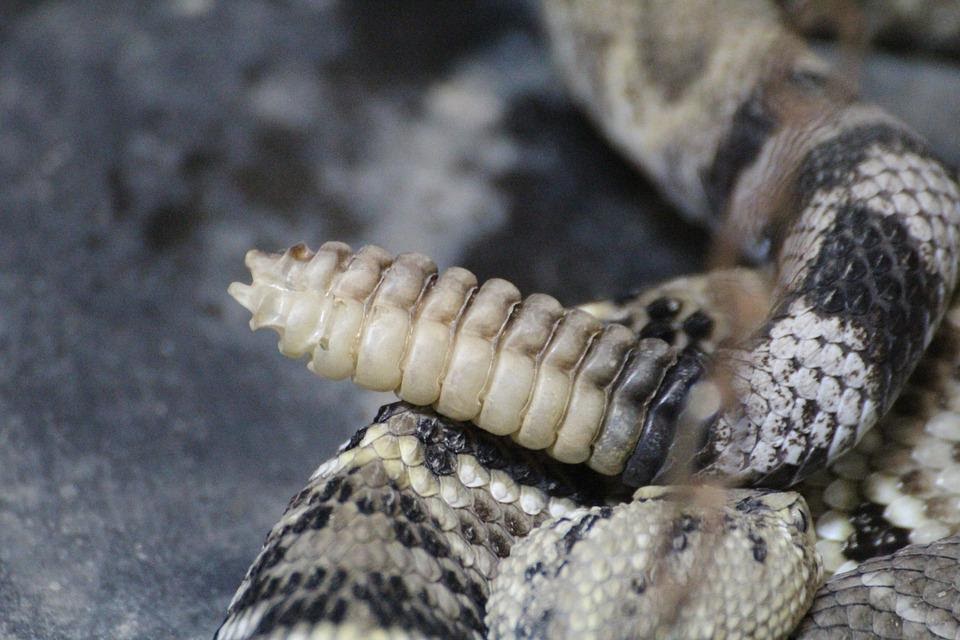
Figure 1. the undivided subcaudal scales that help identify a pit viper. Courtesy of pixabay. https://pixabay.com/photos/rattlesnake-snake-rattle-tail-415339/.
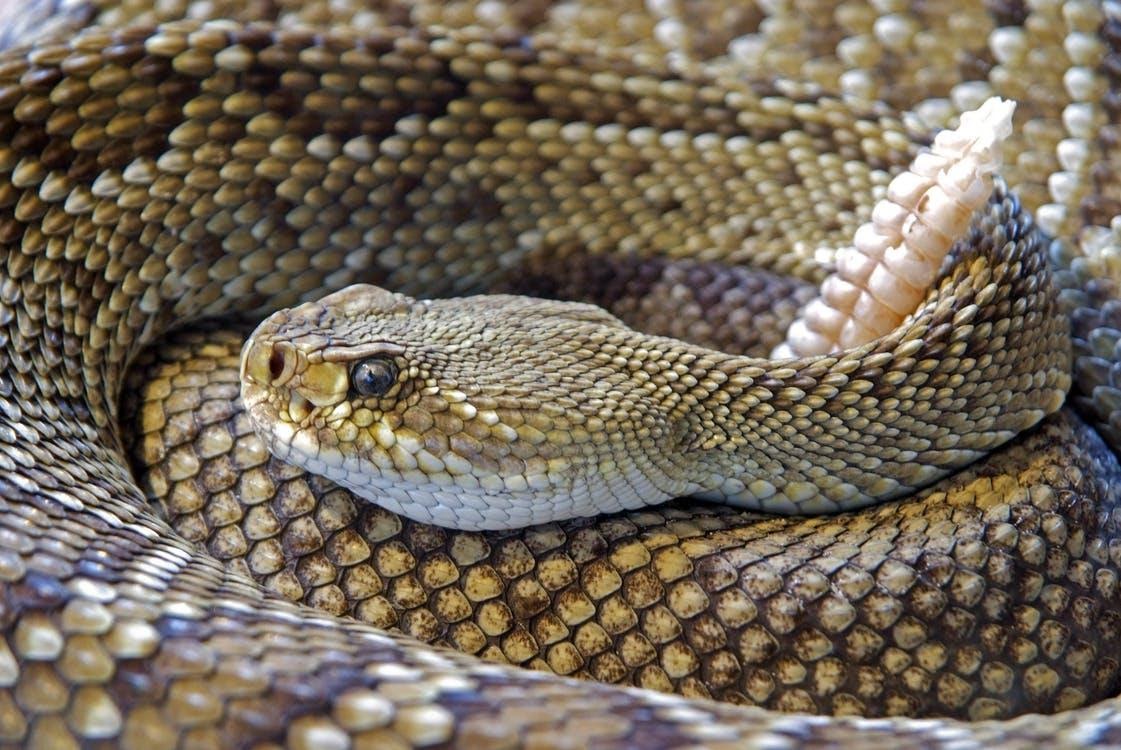
Figure 2. Rattlesnake. Courtesy of pixabay. https://pixabay.com/photos/snake-rattlesnake-reptile-skin-751722/.
Rattlesnakes are distributed throughout the contiguous United States, except for the states of Maine and Rhode Island. They come in a variety of sizes and shapes. In addition to their triangular heads and elliptical pupils, the most distinguishing feature of this group of vipers is the rattle on the end of their tails. This rattle is used as a warning device when the snake feels threatened, but it is not uncommon for hikers to be bitten without ever hearing a rattle.
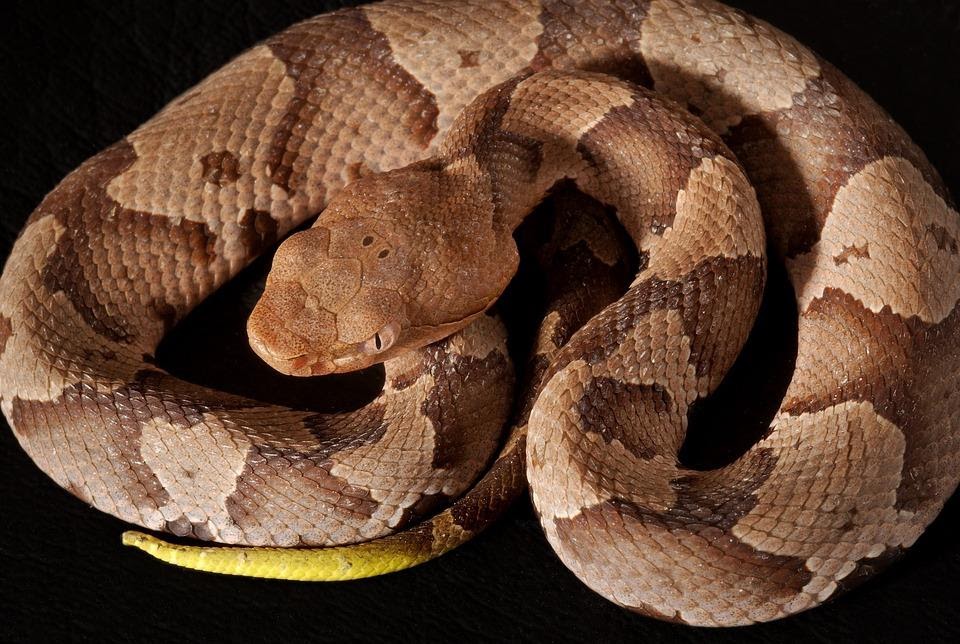
Figure 3. A juvenile copperhead. Courtesy of pixabay. https://pixabay.com/photos/southern-copperhead-viper-poisonous-1329055/.
Copperheads are another venomous species of snakes in North America. They are found in the central and southeastern states and extend to the Big Bend region in Texas. They tend to have copper colored heads, from which they get their name. Also note that as juveniles, they have a yellow tail that they use to attract prey. The yellow tail disappears as they age. They also tend to have dark colored crossbands that are often shaped like an hourglass.
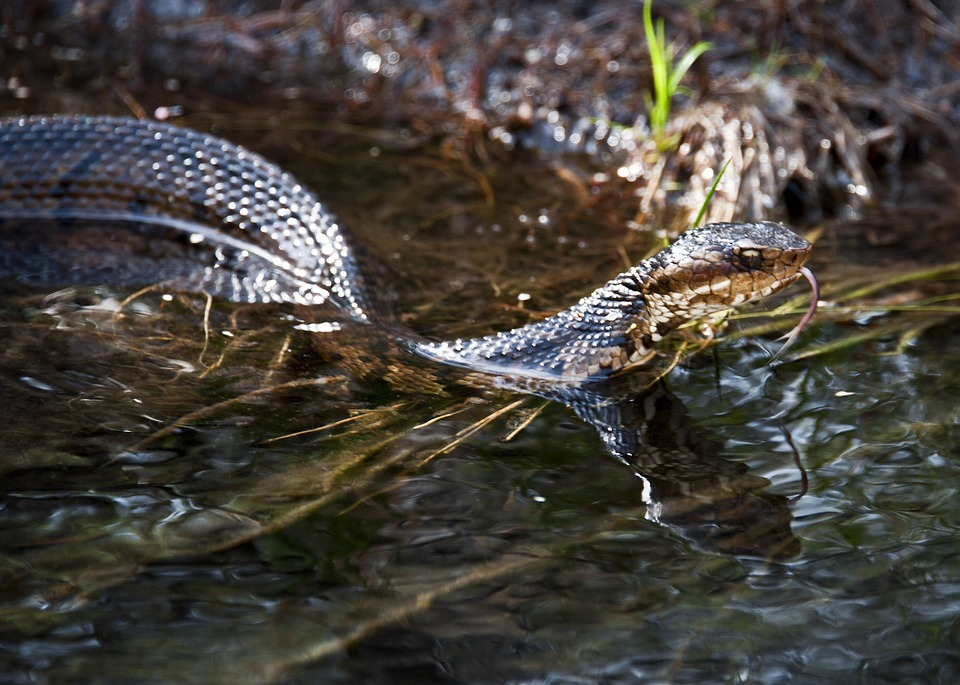
Figure 4. Water moccasin. Courtesy of pixabay. https://pixabay.com/photos/water-moccasin-snake-stream-nature-85609/.
The water moccasin, or cotton mouth, is another venomous snake in the United States. It is found primarily in the southeastern United States. They are usually associated with bodies of water. Interestingly, it is called a cottonmouth because when threatened, it opens its mouth to show its white interior.
Coral Snakes
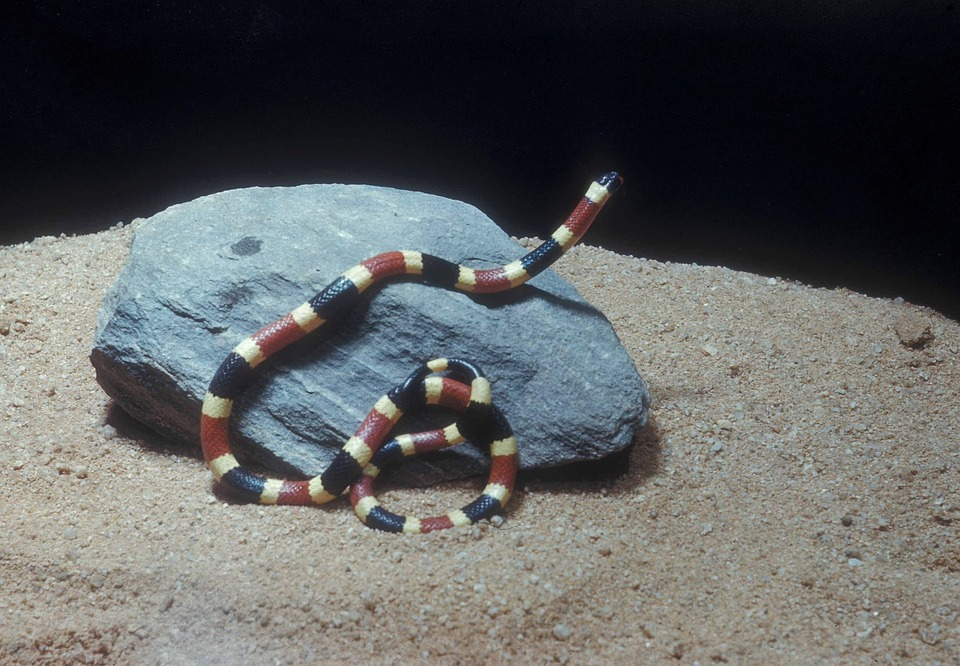
Figure 5. Coral Snake. Courtesy of pixabay. https://pixabay.com/photos/western-coral-snake-reptile-wildlife-1794639/.
Coral Snakes are found primarily in the Southeastern United States and their range extends to Arizona and as far north as Kentucky. To help distinguish coral snakes from other snakes, the rhyme, “Red on yellow, kills a fellow. Red on black, venom lack (or friend of Jack),” is often used. However, it is important to note that this is not 100% true north of Mexico City, and even less true south of it. It is more important to treat based on the case presentation and signs and symptoms as compared to the color markings on the surface of the snake.
Spiders
There are over 40,000 species of spiders. Fortunately, there are only two that cause clinically significant envenomations in North America: the black widow and the brown recluse.
Black Widow Spider
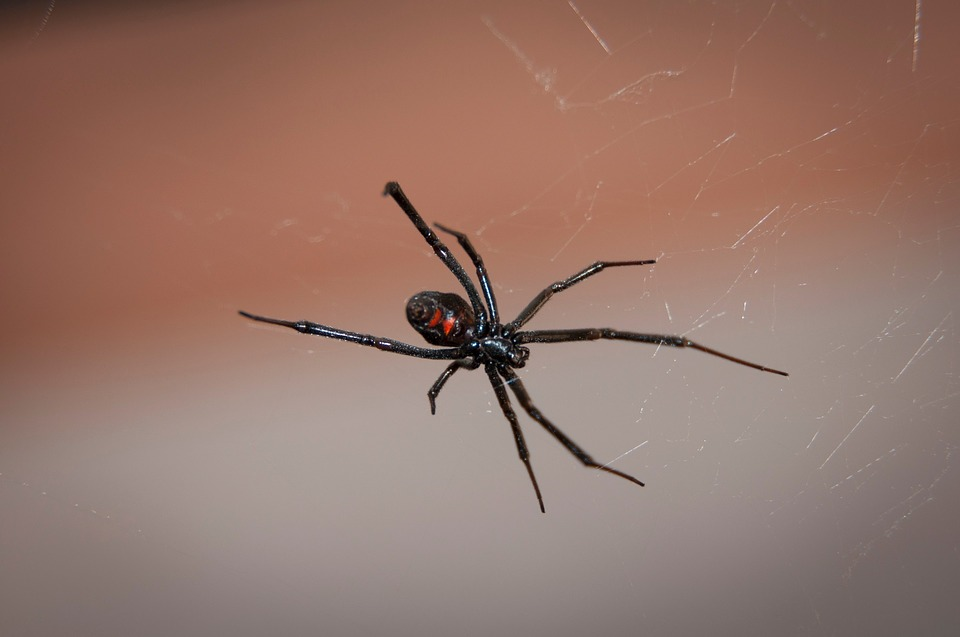
Figure 6. Black Widow spider. Courtesy of pixabay. https://pixabay.com/photos/black-widow-spider-web-arachnid-2042047/.
Black widow spiders are usually between 8 and 10 mm. They are shiny black with a characteristic red hourglass marking on the underside of their abdomen. They tend to spin an irregular web in sheltered corners of fields, gardens and under stones and logs. They are distributed world-wide, but are more common in warmer climates
Brown Recluse
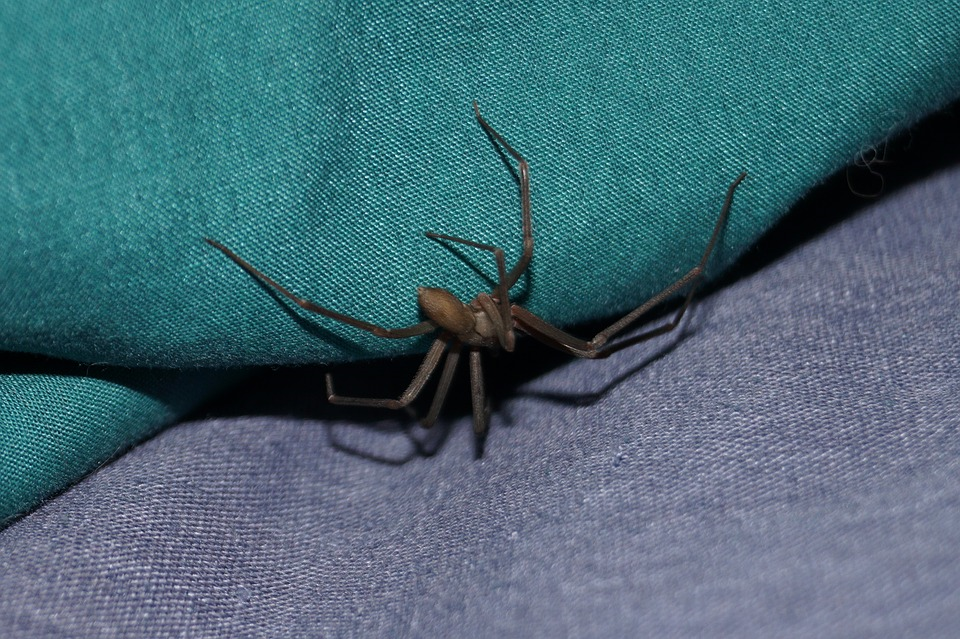
Figure 7. Brown Recluse Spider. Courtesy of pixabay. https://pixabay.com/photos/spider-pest-brown-recluse-1448506/.
The brown recluse can be found throughout North America, but most commonly in the Southern United States. They tend to be between 8 and 15 mm, and light to dark brown. Classically, they have a violin-shaped spot centered cephalad on its abdomen, with the neck of the fiddle pointing caudad.
Bark Scorpion
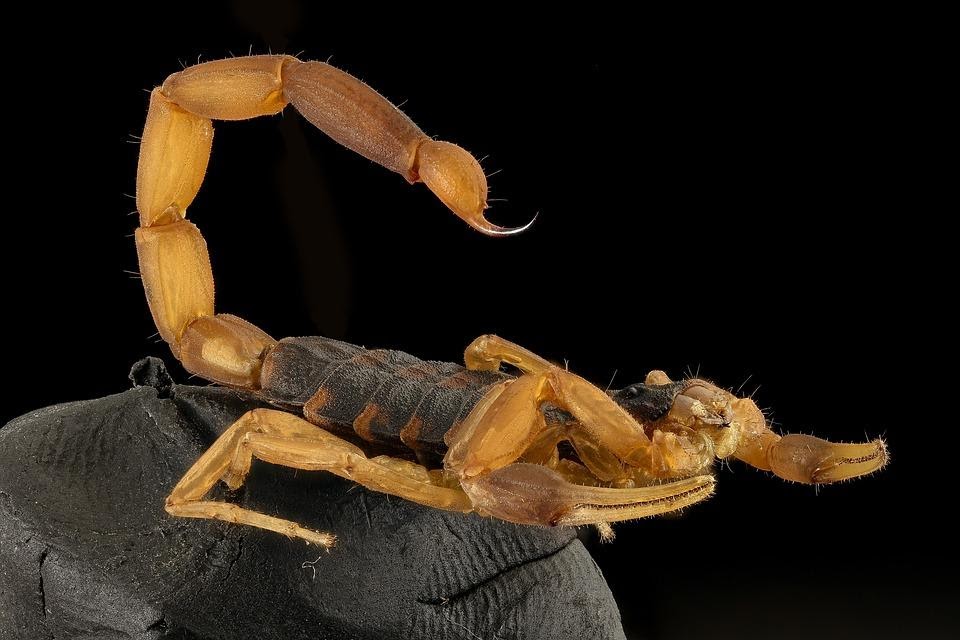
Figure 8. Bark scorpion. Courtesy of pixabay. https://pixabay.com/photos/scorpion-striped-bark-mounted-macro-2789321/.
The bark scorpion is found throughout Arizona and parts of Texas, New Mexico, California and Nevada. They are small, about 5cm in length and have a body that is brown, tan or yellow. They have pincers and a tail that is tall and thin. They often hide under wood (old stumps, lumber piles) and may hide in shoes, blankets and clothing left on the floor.
Presentation
The initial presentation varies with the kind of envenomation, and we will delve into the different types of envenomations in more detail.
Snakes
In general, snake bite envenomations contain toxins that cause either coagulopathy from thrombin-like glycoproteins or neurotoxicity, depending on the species of snake and its corresponding toxin.
Pit Viper Envenomation
If an individual is unlucky enough to suffer a bite from a pit viper, they usually immediately feel a sense of impending doom. The subsequent symptoms depend on the composition of the venom, which is notoriously variable from species to species and from region to region.
Quite often patients will present with soft tissue swelling, necrosis, bullae and exquisite pain around the bite site. These symptoms must be watched closely as they can progresses to involve the extremity and progresses proximally. The swelling can be so profound as to cause compartment syndrome. Others systemic symptoms include nausea, weakness, muscle fasciculations, change in taste sensation (metallic) and sensory changes. Patients who suffer from a pit viper envenomation may also suffer from a coagulopathy that can be quite profound. In addition, in severe envenomations, the patient can become hypotensive requiring aggressive resuscitation, which may be due to pooling of blood in the splanchnic and lung beds. The patients may also develop pulmonary edema from the increase in vascular permeability. In severe cases, DIC may occur.
In contrast, some species of rattlesnakes predominantly produce neurotoxins. Classically, a few populations of the Mohave rattlesnake and the Eastern Diamondback have venoms that have more of a neurotoxic effect. These patients can present with paresthesias at the bite site, proximal muscle weakness and cranial nerve palsies. Respiratory depression necessitating intubation can occur.
It is important to note that it may take more than 8 hours for symptoms to occur after a bite, so observation is important. Up 30% of pit viper snakebites are dry bites, resulting in no delivery of venom.
Coral Snake Envenomation
Patients with coral snake envenomations suffer from the effects of neurotoxins. The primary neurotoxin in coral venom is a post-synaptic neurotoxin that blocks acetylcholine binding sites at the neuromuscular junction. The primary symptoms that a patient presents with include paresthesias at the bite site, descending paralysis and cranial nerve palsies. The paralysis may affect the respiratory muscles, necessitating intubation. Additional symptoms include nausea, vomiting, headache, abdominal pain, diaphoresis and pallor.
Coral snakes have less efficient venom delivery systems compared to pit vipers, so only about 40% of coral snake bites have venom delivery. Fang marks are often difficult to find.
Spiders
Black Widow Spider Envenomation
At the bite site, the local reaction is typically trivial, with only a tiny papule or punctum visible on examination. There may be some surrounding erythema and induration. Most bites tend to not progress beyond this.13 However, some bites progress to severe manifestations with neurologic and systemic manifestations. Black widow venom contains a notable toxin called α-latrotoxin, which induces neurotransmitter release from nerve terminals.
Acutely, severe envenomations may present with hypertension, autonomic and central nervous dysfunction and abdominal pain. The abdominal pain can be so severe that it has been mistaken for an acute abdomen. Patients can also suffer from diaphoresis, fasciculations and severe muscle spasms. The pain from the muscle spasms and abdominal pain can be refractory to opioids.
Brown Recluse Envenomation
A cytotoxic venom is released by the brown recluse spider. Mild envenomations may cause mild and transient skin irritation and more severe envenomations may cause large ulcers with areas of necrosis that need debridement. These ulcers may cause significant scarring and take many months to heal. Severe, systemic symptoms are rare, but include hemolytic anemia and acute renal injury.
Bark Scorpion
The venom from a Bark Scorpion envenomation blocks inactivation of neuronal sodium channel, which increases cholinergic and adrenergic stimulation. Mild envenomations present with mild local swelling and paresthesias at the bite site. More severe envenomations can be quite debilitating with quite an impressive presentation. Symptoms include tongue and muscle fasciculations, gross skeletal motor hyperactivity, ballistic motor activity, opsoclonus, and salivary gland hypersecretion. Pancreatitis may also be seen with some scorpion stings. A grading rubric for assessment of degree of scorpion envenomation and corresponding algorithm for treatment is available. In severe cases, hyperthermia, rhabdomyolysis, metabolic acidosis, pulmonary edema, respiratory and multisystem organ failure can occur. Severe symptoms are rare, but may occur in children and infrequently in adults.
Diagnostic Testing
To identify the etiology of envenomation, laboratory testing is rarely helpful as it is often a clinical diagnosis. A good history, physical and observing the clinical course is usually the only data needed to determine the etiology of envenomation. As described above, quite often a patient will bring a photo of the creature, or the actual creature itself. This can be helpful to identify the nature of envenomation.
Snakes
In general, it is rare for a fang to break off during an envenomation. The routine use of radiographs to assess for a foreign body after an envenomation is not recommended.
Pit Viper Envenomation
Even though laboratory testing is not helpful to assess the presence of an envenomation, it is helpful in guiding the management of a pit viper envenomation. In the table below are some tests to consider performing in a pit viper envenomation.
Table 1. Diagnostic Testing for the pit viper envenomation
Coral Snake Envenomation
Laboratory testing is rarely helpful in the management of coral snake envenomations. If you are concerned about a patient’s respiratory status, an ABG may be helpful as well as bedside spirometry and negative inspiratory force to assess the need for intubation.
Spider Envenomations
Lab testing is rarely helpful in the management of an acute envenomations by spiders in North America unless systemic symptoms are present. Then routine lab testing in addition to CK may be indicated.
Bark Scorpion Envenomation
There is no diagnostic testing that is readily available that can help identify a bark scorpion envenomation.
Treatment
For most bites and stings, appropriate first aid is the mainstay of treatment. Removal of spines, stingers, tentacles and fangs using proper protective gear is the first step. Washing the affected site, local wound care and applying ice to reduce swelling are helpful. The affected extremity should be closely examined for edema and signs of compartment syndrome, while, at the same time, the patient’s hemodynamic status and blood pressure should be monitored. Additional treatments include parenteral analgesia and tetanus prophylaxis.
It is important to note that in the past, there has been a variety of ways to initially take care of a pit viper envenomation that have not been shown to be helpful. This list includes: tourniquets, incising the wound and sucking out the venom, and the Sawyer Venom Extractor. These are not recommended.
Initial first aid for pit viper envenomation includes management of the ABC’s and elevation of the affected extremity. Marking an area of edema can be helpful to guide the response to therapy. In addition, all constrictive jewelry, clothing and accessories should be removed.
Below, we will discuss the management of the different envenomations in more detail.
Snakes
Pit Viper Envenomation
Initial first aid for pit viper envenomation includes management of the ABCs and immobilization and elevation of the affected extremity. Marking an area of edema is also essential and should be done every 15 to 30 minutes. In addition, all constrictive jewelry, clothing and accessories should be removed.
For any patient with a pit viper envenomation, antivenom should be strongly considered. Patients with anything other than minimal, nonprogressive symptoms or those with lab abnormalities are likely candidates. It is recommended that the provider contact a medical toxicologist (or other experienced specialist) such as those available at the poison center at 1-800-222-1222 prior to administration of antivenom. In the United States, the preferred antivenom is CroFab. CroFab is an, ovine polyvalent immune Fab that is created from the venoms of four different snakes: Eastern Diamondback, Western Diamondback, Mohave rattlesnake and the Water Moccasin. It is important to note that CroFab can have an immediate hypersensitivity reaction in up to 8% of administrations, so clinicians should monitor patients closely for anaphylaxis.
While swelling is common, other manifestations may arise. Rarely, compartment syndrome in the context of a pit viper envenomation may occur but the first-line therapy is not a surgical fasciotomy, which carries significant morbidity, but administration of antivenom. For patients who develop hypotension, antivenom along with aggressive fluid resuscitation is recommended and vasopressors may be required. Respiratory support should be given as needed.
Snakebites rarely get infected, so the routine use of antibiotics is not indicated. All patients with a pit viper envenomation should be managed with the assistance of Poison Control Center or your local toxicologist. It should also be noted that all patients with a suspected pit viper envenomation should be monitored for a minimum of 8-12 hours, and all patients with envenomation and those who receive antivenom require admission to the hospital.
Coral Snake Envenomation
Since coral snake venom contains neurotoxins, diaphragmatic paralysis following envenomation is of significant concern. The patient’s airway should be managed aggressively, and any sign of respiratory dysfunction should prompt consideration of early intubation.
The mainstay of treatment is the Wyeth antivenom, which is equine based. Most hospitals do not stock this antivenom, so contacting Poison Control or a toxicologist is helpful not only for assistance with management, but also in locating the antivenom. Most zoos carry the antivenom and can be contacted to obtain the antivenom. It is important to note that this antivenom does carry a significant risk of serum sickness.
All patients with a coral snake envenomation, even if asymptomatic, should be admitted for close airway monitoring for 24 hours.
Spiders
Black Widow Spider Envenomation
Patients who experience an envenomation by a black widow spider often suffer from a large amount of pain and muscle spasm. In addition to local wound care and tetanus prophylaxis, aggressive pain control should be obtained with significant doses of parenteral opioids and suppression of muscle spasms with IV benzodiazepines, and control of nausea with IV antiemetics. The hypertension can be quite profound, and may improve with treatment of the pain. If not, intravenous anti-hypertensives may be indicated. Note that for severe envenomation an antivenom has been developed and has proven effective in rapidly controlling the pain and systemic symptoms, but consultation with a medical toxicologist at the poison center is strongly advised: 1-800-222-1222, or in Australia at 13 11 26.
Brown Recluse Envenomation
The treatment often varies on the severity of envenomation. For cutaneous lesions, ulcers can be managed as an outpatient with pain control and cold compresses. After the initial swelling has subsided, necrotic lesions may need debridement to define the margins of the central eschar (1-2 weeks after envenomation), but early surgical debridement is not recommended. Treatments with dapsone and glucocorticoids are also no longer recommended. Patient with systemic symptoms should be admitted and provided with supportive care.
Bark Scorpion Envenomation
For patients with only local signs and symptoms, only local wound care and pain control is indicated. For patients with more severe symptoms supportive care should be given, and opioids and benzodiazepines have great value. There is an antivenom, (Anacorp) that is an equine-based Fab that has been shown to rapidly improve symptoms. This may be given in higher grade or severe envenomations in consultation with the poison center.
Pearls and Pitfalls
- Inappropriate initial actions after a snake bite include: tourniquets, incision and/or suction of the wound, and venom extraction devices.
- Consultation should be made with a specialist experienced in the treatment of envenomations. Physicians should contact their Poison Control Center or a toxicologist for assistance at 1-800-222-1222.
- The muscle rigidity of black widow spiders may be severe. If it involves the abdominal musculature, the envenomation may be mistaken for an acute abdomen.
- Patients should be treated based on the symptoms that they present with, rather than relying on physical identification of the creature.
Case Study
Based on the symptoms described, the physician rapidly deduces that the patient has a pit viper envenomation. The physician rapidly starts aggressive fluid hydration, vasopressors, and starts CroFab. The physician also contacts the Poison Center and they continue to follow the patient in the ICU. The patient improves and is discharged from the hospital two days later with no long term sequelae.
References
A short list of important articles with the PubMed links / ID numbered and alphabetical. In-text references not needed
Auerbach PS, Cushing TA, Harris NS. Auerbach's wilderness medicine. Seventh edition. ed. Philadelphia, PA: Elsevier; 2017.
Bronstein AC, Spyker DA, Cantilena LR, Green JL, Rumack BH, Giffin SL. 2008 Annual Report of the American Association of Poison Control Centers' National Poison Data System (NPDS): 26th Annual Report. Clin Toxicol (Phila). 2009;47(10):911-1084Merriam-Webster Inc. The Merriam-Webster dictionary. Springfield, Massachusetts: Merriam-Webster, Incorporated; 2019.
Bronstein AC, Spyker DA, Cantilena LR, Green JL, Rumack BH, Giffin SL. 2009 Annual Report of the American Association of Poison Control Centers' National Poison Data System (NPDS): 27th Annual Report. Clin Toxicol (Phila). 2010;48(10):979-1178.
Bronstein AC, Spyker DA, Cantilena LR, Green JL, Rumack BH, Dart RC. 2010 Annual Report of the American Association of Poison Control Centers' National Poison Data System (NPDS): 28th Annual Report. Clin Toxicol (Phila). 2011;49(10):910-941.
Bronstein AC, Spyker DA, Cantilena LR, Rumack BH, Dart RC. 2011 Annual report of the American Association of Poison Control Centers' National Poison Data System (NPDS): 29th Annual Report. Clin Toxicol (Phila). 2012;50(10):911-1164.
Coral Snake. https://en.wikipedia.org/wiki/Coral_snake. Published 2019. Accessed2019.
Jansen PW, Perkin RM, Van Stralen D. Mojave rattlesnake envenomation: prolonged neurotoxicity and rhabdomyolysis. Ann Emerg Med. 1992;21(3):322-325.
Jelinek GA, Banham ND, Dunjey SJ. Red-back spider-bites at Fremantle Hospital, 1982-1987. Med J Aust. 1989;150(12):693-695.
Mowry JB, Spyker DA, Cantilena LR, Bailey JE, Ford M. 2012 Annual Report of the American Association of Poison Control Centers' National Poison Data System (NPDS): 30th Annual Report. Clin Toxicol (Phila). 2013;51(10):949-1229.
Mowry JB, Spyker DA, Cantilena LR, McMillan N, Ford M. 2013 Annual Report of the American Association of Poison Control Centers' National Poison Data System (NPDS): 31st Annual Report. Clin Toxicol (Phila). 2014;52(10):1032-1283.
O'Connor A, Ruha AM. Clinical course of bark scorpion envenomation managed without antivenom. J Med Toxicol. 2012;8(3):258-262.
Russel FE. Snake Venom Poisoning. In. New York: Scholium International; 1983.
